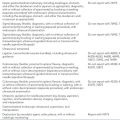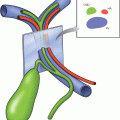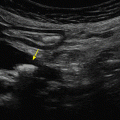The American Institute for Ultrasound in Medicine
One might look to either a surgery-based or a radiology-based organization to offer guidelines for credentialing for ultrasound for surgeons. The largest ultrasound-specific society in the United States is the American Institute for Ultrasound in Medicine. In its official statement entitled “Training Guidelines for Physicians Who Evaluate and Interpret Diagnostic Ultrasound Examinations” approved on November 6, 2010, the AIUM outlines stringent criteria for training (full document may be found in Appendix 1). Outside of specialty certifications in breast, neck, trauma, obstetrics and gynecology, and musculoskeletal ultrasound, the association dictates the performance, evaluation, and interpretation of at least 300 sonograms, in addition to 100 hours of didactic lesson. This implies that a surgeon with a practice concentration in the abdominal arena will not be considered competent by the AIUM until they have been using ultrasound for likely a period of years. Contrast this to the “learning curve” for a laparoscopic cholecystectomy during the time of its adoption, where numbers oft-quoted were in the range of 25 to 50 cases. Dr. Grace Rozycki, a pioneer in surgical ultrasound and steadfast proponent of surgeon-performed procedures, argues that this does not apply to surgeons for the following reasons: (1) a surgeon has the benefit of direct responsibility for the patient, and thus is more familiar with the patient’s anatomy, symptomatology, and disease process than a technician or impartial proceduralist;(2) knowledge of three-dimensional anatomy is enhanced by the surgeon’s operative experience; and (3) surgeon-performed ultrasounds are generally more focused, with the “ask question, get answer” approach. Although it may be instinctive to look to an ultrasound specialty society for guidance on credentialing ultrasound, in this author’s opinion, the naiveté to a surgeon’s practice, in fact, hinders proper judgment and is even dangerous if looked to for guidance by payers, litigation specialists, and the like.
 The American College of Surgery
The American College of Surgery
For reasons that become obvious it is more appropriate for surgeons (and other interventionalists) to govern the adoption of ultrasound for themselves, knowing the full scope of the application of the technique as well as the applicability to the physician’s practice. Looking now to the model described earlier for adoption of emerging technologies, the full and exemplary history of the American College of Surgery as a proponent and governor of surgeon-performed ultrasound is described.
The first ultrasound session at the national meeting of the ACS occurred in 1995 at the 80th Clinical Congress in New Orleans, with a general session entitled “The Surgeon and Ultrasound”. The day-long meeting included discussions on ultrasound physics, breast, colorectal, hepatobiliary, vascular, laparoscopic, and trauma ultrasound. In addition, even at that earliest meeting, recognition of the importance of certification was apparent with a lecture entitled “Credentialing, Liability, and Turf Wars.” Following rapidly was the first meeting of a core group of early adopters, the ACS Ultrasound Users Group. The goals and objectives of this meeting were enumerated: develop course of instruction for ACS, develop educational format for US, interface with manufacturers, interface with ACS hierarchy, and interface with ABS (American Board of Surgery) and APDS (Association of Program Directors in Surgery). The first postgraduate course was held at the 24th Spring Meeting in April 1996 in New York. A National Ultrasound Faculty was approved by the ACS Board of Regents in 1998. Key to this organization’s responsibility was the development of an Ultrasound “Blue Book,” or ultrasound educational program for surgeons and surgical residents. Quoting from the preface, “A voluntary verification process for surgeons performing ultrasound has been created and is intended to ensure that surgeons who use ultrasound are qualified and that the ultrasound facilities and equipment they use are appropriate for the medical application and met and maintain quality standards.” Quickly a Verification Program was endorsed for surgeons and surgical residents, and included three components: Level 1, verification of attendance; Level 2, verification of satisfactory completion of course objectives; and Level 3, instructor. This program was constructed with modules, including both a curriculum in basic ultrasound and numerous advanced, specialty curricula.
The official statement developed by the College’s Committee on Emerging Surgical Technology and Education (CESTE) was approved by the Board of Regents in the February 1998 meeting and may be found in Appendix 2. Briefly, it insures the surgeon either received adequate training in basic ultrasonography during residency, or acquired this knowledge through a basic approved educational program. This statement then describes the qualifications for use of specialty ultrasound, including knowledge of the specialty itself as well as documentation of expertise in the application of ultrasound to this specialty area (ie, by evidence of formal training or by examination). Recommendations for maintenance of skills by individuals as well as facility guidelines complete this document.
 The Society for American Gastrointestinal Endoscopic Surgeons
The Society for American Gastrointestinal Endoscopic Surgeons
SAGES can perhaps be considered a surgical specialty society for the adoption of advanced surgical technologies, particularly in the field of “general” surgery. As such, in January 2011, SAGES released their own privileging guidelines for institutions granting ultrasonography privileges to surgeons. The full document is found in Appendix 3, but will be summarized here.
Interestingly and uniquely, this document specifically addresses hospital credentialing committees. It also specifies that ultrasonography privileges should be granted separately for each major category of practice, ie, trauma, abdominal, vascular, thoracic, urology, and gynecology. This document outlines explicit, minimum requirements for granting privileges in ultrasound. First is successful completion of an ACGME-accredited surgical residency program. If this program incorporated a structured experience in ultrasonography, documentation of this is to be provided. If the residency program did not include such training, a separate, structured training program is required. They indicate curriculum requirements such as didactic training and hands-on scanning with animate or inanimate models, and suggest courses such as those offered by the ACS or SAGES. Lastly, an applicant’s experience should be adequate and documented as an appropriate number of cases, including proctored cases. The particular number of cases is left to the discretion of the institution. Further discussion is directed to maintenance of privileges, with guidelines for granting of provisional privileges, monitoring of performance, renewal of privileges, and denial of privileges with mechanisms for appeal.
NECK ULTRASOUND
The utility of ultrasound in the neck for diagnosis and treatment of various endocrine disorders is well established. The American Association of Clinical Endocrinologists (AACE) is a specialty society for physicians (largely medical specialists in endocrinology) who provide expertise in thyroid and parathyroid disorders. This group has established a certification in neck ultrasound, and provides a comprehensive handbook for the achievement and maintenance of this certification. Unlike the above general guidelines, the AACE is the sponsor of a formal course for neck ultrasound certification (ECNU, Endocrine Certification in Neck Ultrasound). Although neither required nor recognized by CMS or major insurers, this rigorous curriculum certainly identifies the necessary credentials and skills for neck ultrasound. This is a three-step program, including a written certifying examination that has a mandatory prerequisite of a thyroid ultrasound course (minimum 15 AMA PRA Category I credits), a validation of technical competency, and finally granting of certification. Certification entitles the recipient to a designation of “ECNU” after his or her name, and is valid for 10 years.
Stay updated, free articles. Join our Telegram channel

Full access? Get Clinical Tree





